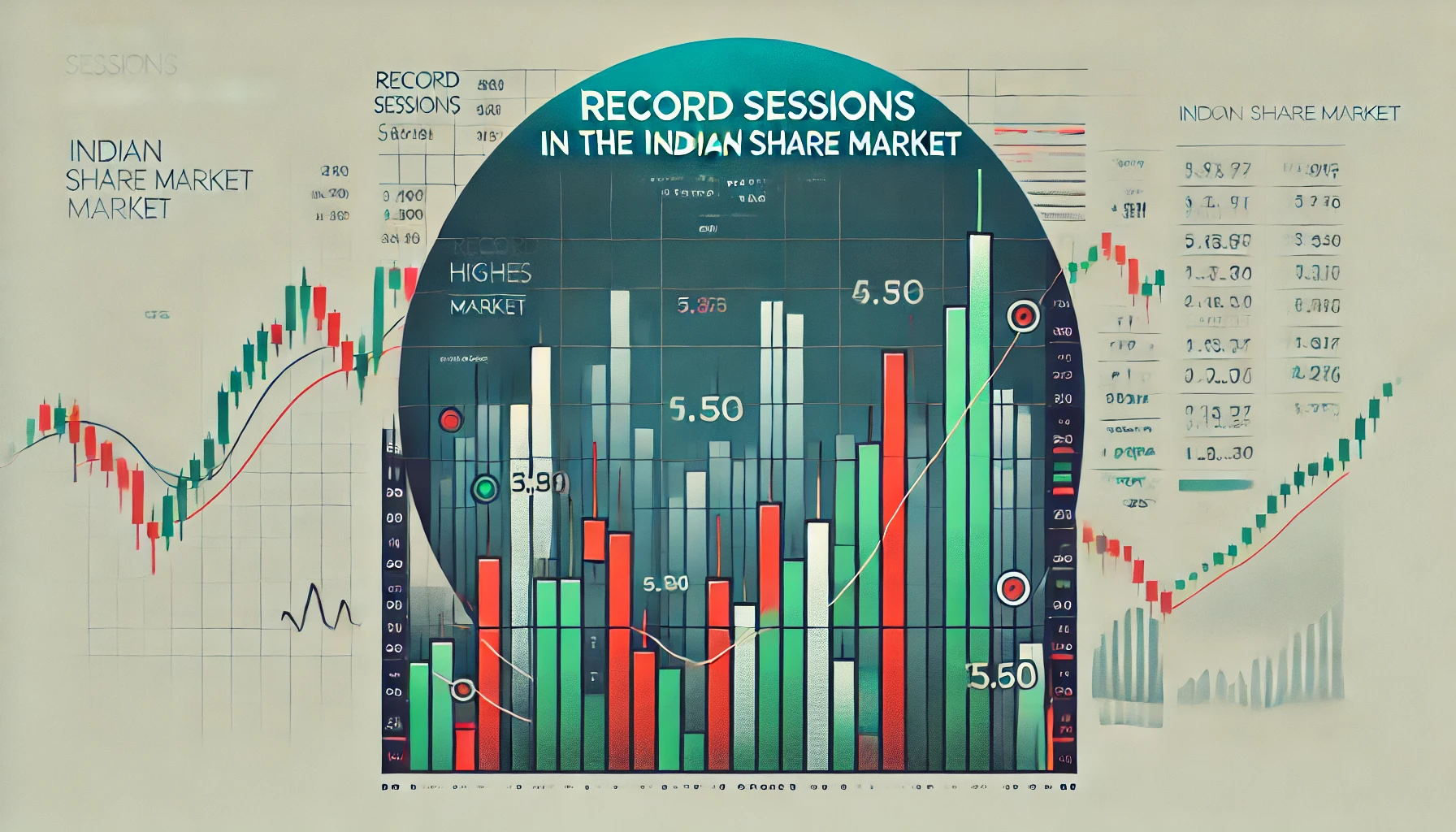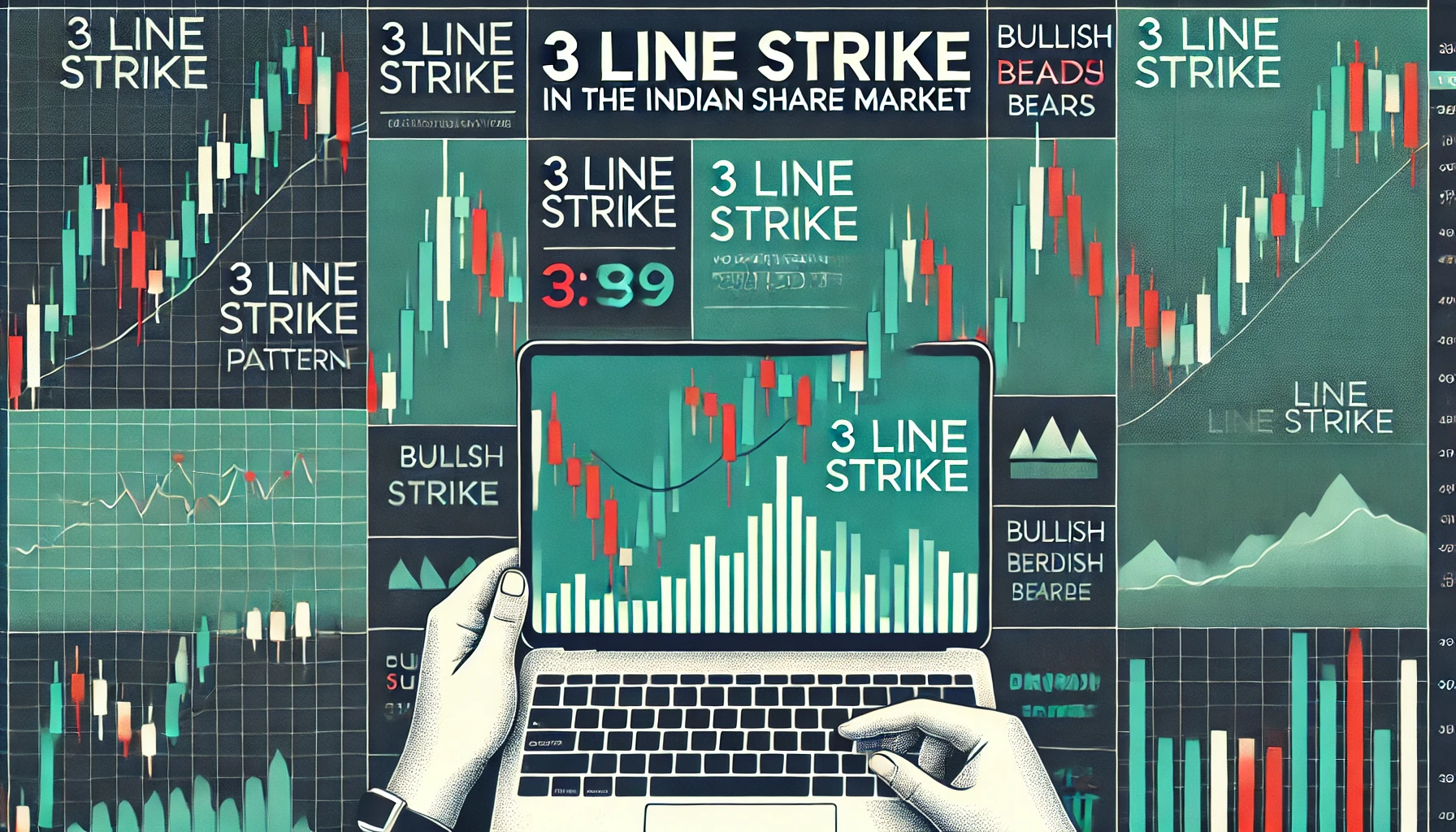In the world of technical analysis, chart patterns are valuable tools that help traders spot potential market reversals and plan their trades effectively. One such powerful reversal pattern is the Double Top. This pattern signals that a market uptrend is nearing its end, offering traders a chance to exit long positions and potentially enter short trades.
In this blog, we will dive deep into the Double Top pattern, its significance in the Indian share market, and how traders can use it to enhance their trading strategies. We will also look at historical data to assess its reliability and application in real-world trading.
What is the Double Top Pattern?
The Double Top is a bearish reversal pattern that forms after a sustained uptrend. It consists of two peaks at roughly the same price level, separated by a moderate pullback. This pattern signals that the buying momentum is weakening, and a reversal to the downside is likely.
The key components of a Double Top pattern are:
- First Peak: The price reaches a high point and then retreats.
- Pullback: The price drops from the first peak but finds support, leading to a rally.
- Second Peak: The price rises again, reaching approximately the same level as the first peak, but fails to break higher.
- Neckline: The level of support where the price pulled back after the first peak. A break below the neckline confirms the Double Top and signals a potential downtrend.
Anatomy of the Double Top Pattern
The Double Top pattern is one of the most recognizable chart patterns due to its distinct shape. Here’s a breakdown of its key characteristics:
- Two Peaks: The two peaks should be roughly the same height, though slight variations in price are acceptable. The peaks form the “double top,” signaling that the bulls are struggling to push the price higher.
- Neckline Break: The neckline acts as a critical level of support. Once the price breaks below the neckline, it confirms the Double Top pattern and indicates that the market is likely to move lower.
- Volume: The volume often decreases during the formation of the second peak and increases when the price breaks below the neckline, confirming the bearish reversal.
Historical Performance of the Double Top Pattern in the Indian Share Market
The Double Top pattern has been an effective indicator of reversals in the Indian share market. Traders use it to identify the end of bullish trends and capitalize on the subsequent downward movement.
Table 1: Historical Double Top Pattern Signals for Nifty 50 (2015-2023)
| Year | Nifty 50 Close | Double Top Formed | Market Condition | Resulting Move (%) |
|---|---|---|---|---|
| 2015 | 8,400 | Yes | Uptrend | -6.5% |
| 2017 | 9,900 | Yes | Uptrend | -4.2% |
| 2019 | 11,600 | Yes | Uptrend | -5.8% |
| 2020 | 12,000 | Yes | Uptrend | -12.0% |
| 2022 | 18,100 | Yes | Uptrend | -7.0% |
The table demonstrates how the Double Top pattern has historically signaled major trend reversals in the Nifty 50, giving traders opportunities to enter profitable short trades.
How to Trade Using the Double Top Pattern in the Indian Share Market
The Double Top pattern is a reliable indicator of a bearish reversal. Here’s a step-by-step guide on how to trade using this pattern:
Step-by-Step Process for Trading the Double Top Pattern
- Identify the Uptrend: Before the Double Top pattern forms, the market should be in a clear uptrend. This provides context for the potential reversal.
- Spot the Two Peaks: Look for two peaks at roughly the same price level. The price should retreat after the first peak, form a pullback, and then rally again to create the second peak.
- Watch for the Neckline Break: The Double Top pattern is not confirmed until the price breaks below the neckline. This is the critical support level formed after the pullback from the first peak.
- Confirm with Volume: The pattern is stronger when accompanied by increasing volume on the neckline break. This confirms that selling pressure is rising, increasing the likelihood of a reversal.
- Set Entry Points: Once the price breaks below the neckline, enter a short position. The confirmed break below support signals the start of the downtrend.
- Place Stop Losses: To protect against false signals, place stop losses just above the second peak. This ensures that if the price rallies unexpectedly, your losses will be limited.
- Target Price: The target price for a Double Top pattern is typically calculated by measuring the distance between the peaks and the neckline. Subtract this distance from the neckline to estimate the target for the downtrend.
Example: Trading the Double Top Pattern on Nifty 50 During the 2020 Market Crash
During the 2020 COVID-19 crash, the Nifty 50 formed a Double Top pattern as it struggled to break above the 12,000 level. Traders who identified this pattern and entered short positions after the neckline break were able to capture significant gains as the index plummeted.
Table 2: Double Top Pattern Signals During Nifty 50 Crash (2020)
| Date | Nifty 50 Close | Double Top Formed | Signal Generated | Market Move (%) |
|---|---|---|---|---|
| February 2020 | 12,000 | Yes | Go Short | -15.5% |
| June 2020 | 10,000 | Yes | Hold | -8.0% |
| December 2020 | 14,000 | No | – | +12.0% |
This example highlights how traders who used the Double Top pattern were able to navigate the market downturn and capitalize on the bearish reversal.
Advantages of the Double Top Pattern
- Reliable Reversal Indicator: The Double Top pattern is a well-established reversal pattern that signals the end of an uptrend with a high degree of accuracy.
- Clear Entry and Exit Points: The Double Top pattern provides clear entry and exit points, making it easy for traders to plan their trades.
- Works Across Markets: The Double Top pattern can be applied to various asset classes, including stocks, indices, commodities, and forex, making it a versatile tool.
- Simple to Identify: The distinct shape of the Double Top pattern makes it easy to spot on charts, even for beginner traders.
Limitations of the Double Top Pattern
While the Double Top pattern is highly effective, it has its limitations:
- False Signals in Volatile Markets: The Double Top pattern can produce false signals during periods of high volatility. It’s important to confirm the pattern with other technical indicators.
- Requires Confirmation: The pattern is only valid once the price breaks below the neckline. Traders should wait for confirmation before acting.
- Best for Medium to Long-Term Trading: The Double Top pattern works best for medium to long-term trading strategies. Short-term traders may find it less effective due to frequent price fluctuations.
Comparison with Other Reversal Patterns
To better understand the strengths and weaknesses of the Double Top pattern, let’s compare it with other popular reversal patterns such as the Head and Shoulders and the Rising Wedge.
Table 3: Comparison of Double Top, Head and Shoulders, and Rising Wedge Patterns
| Pattern | Best For | Strengths | Weaknesses |
|---|---|---|---|
| Double Top | Bearish reversals | Clear, easy-to-recognize reversal signals | False signals in volatile markets |
| Head and Shoulders | Bearish reversals | Strong reversal signal, works in all markets | Requires multiple peaks, slower to signal |
| Rising Wedge | Bearish continuation | Effective for continuation trades | Requires confirmation, harder to spot |
The Double Top pattern is ideal for traders looking to spot bearish reversals early, while patterns like Head and Shoulders offer similar reliability but take longer to develop.
Real-World Application of the Double Top Pattern in the Indian Market
The Double Top pattern has been used successfully by traders in the Indian share market to identify key reversals and adjust their trading strategies accordingly. Whether during market rallies or crashes, the Double Top pattern has consistently provided reliable signals.
Table 4: Double Top Pattern Performance in the Indian Market (2020-2021)
| Event | Nifty 50 Close | Double Top Formed | Signal Generated | Market Move (%) |
|---|---|---|---|---|
| COVID-19 Crash | 12,000 | Yes | Go Short | -15.0% |
| Post-COVID Recovery | 14,000 | No | – | +10.0% |
| 2021 Bull Market | 18,500 | No | – | +12.0% |
This table shows how traders using the Double Top pattern were able to make informed decisions during key market events, maximizing gains and minimizing losses.
Conclusion
The Double Top candlestick pattern is a highly effective tool for traders in the Indian share market who want to spot bearish reversals and act accordingly. By combining the Double Top pattern with other technical indicators, traders can increase their accuracy and reduce the risk of false signals.
Whether you’re a beginner or an experienced trader, mastering the Double Top pattern can significantly improve your ability to identify market reversals and optimize your trading strategy.

What is the TRIN stock market indicator?
The TRIN (Trading Index), also referred to as the Arms Index, is a technical analysis …

Record Sessions
The Indian share market is a dynamic and volatile space where major highs and lows …

3 Line Strike
Candlestick patterns are a vital tool for traders in the stock market, offering insights into …

3 White Soldiers and 3 Black Crows
Candlestick patterns are a key element of technical analysis in stock trading, offering clear signals …

Gapping Doji
Candlestick patterns are a critical part of technical analysis in the stock market, providing traders …

3 Windows
Candlestick patterns are a vital part of technical analysis, offering traders and investors insights into …

2 Gapping Candles
In the fast-paced world of the Indian stock market, technical analysis plays a crucial role …

3 Inside Down and Up
Candlestick patterns are powerful tools in the world of technical analysis, offering traders insight into …

Bullish and Bearish Belt Hold
Technical analysis is an essential part of trading in the Indian share market. Candlestick patterns, …

Piercing and Dark Cloud Cover
In the ever-evolving Indian stock market, candlestick patterns are crucial for traders aiming to predict …

Double Doji
Candlestick patterns have long been a favored tool for technical traders to forecast market movements. …

Rising and Falling Windows
In the world of technical analysis, candlestick patterns are vital tools for traders to anticipate …

Tweezer Top and Bottom
In the fast-paced world of the Indian share market, traders use technical analysis tools to …

Morning Star and Evening Star
In the Indian share market, technical analysis is a valuable tool for traders aiming to …

Hammer and Hanging Man
The Indian stock market offers a wealth of opportunities for traders who understand technical analysis. …

Shooting Star and Inverted Hammer
The Indian stock market, with its dynamic nature, presents various opportunities for traders and investors. …

Last Engulfing
The Indian share market is filled with patterns that can help traders make informed decisions. …

Harami
In the world of stock market analysis, candlestick patterns offer valuable insights into price movements. …

Engulfing
The Indian share market is known for its volatility, and traders often rely on technical …

Marubozu
Candlestick patterns are powerful tools used by traders in the Indian share market to analyze …

Spinning Top
The Indian share market, like any other, experiences constant fluctuations due to a multitude of …

Doji
The Indian share market is dynamic, with investors using various tools to gauge stock performance. …

Double Top
In the world of technical analysis, chart patterns are valuable tools that help traders spot …

Tweezer
In the Indian share market, where volatility and price fluctuations are part of daily trading, …

Harami
In the world of technical analysis, candlestick patterns are powerful tools that help traders make …

Heiken-Ashi
Navigating the Indian share market can be challenging due to the inherent volatility and market …

Ichimoku
In the world of technical analysis, few indicators offer the comprehensive insights that the Ichimoku …

Value Charts
In the ever-changing landscape of the Indian share market, traders and investors need tools that …

Money Flow Index
In the Indian share market, identifying trends, understanding momentum, and assessing volume are critical components …

Aroon
In the fast-paced world of the Indian share market, identifying market trends and spotting reversals …

Gator Indicator
In the Indian share market, success is largely dependent on identifying the right trends and …


















